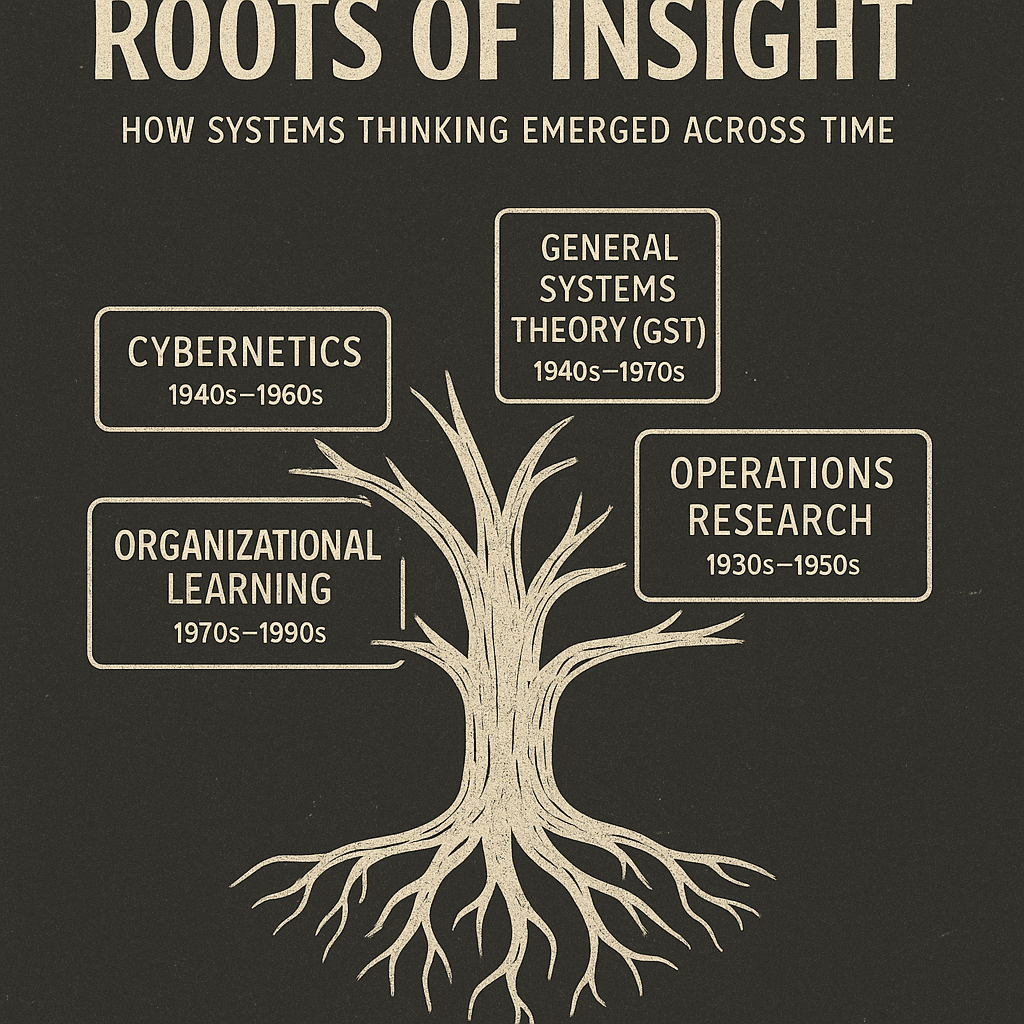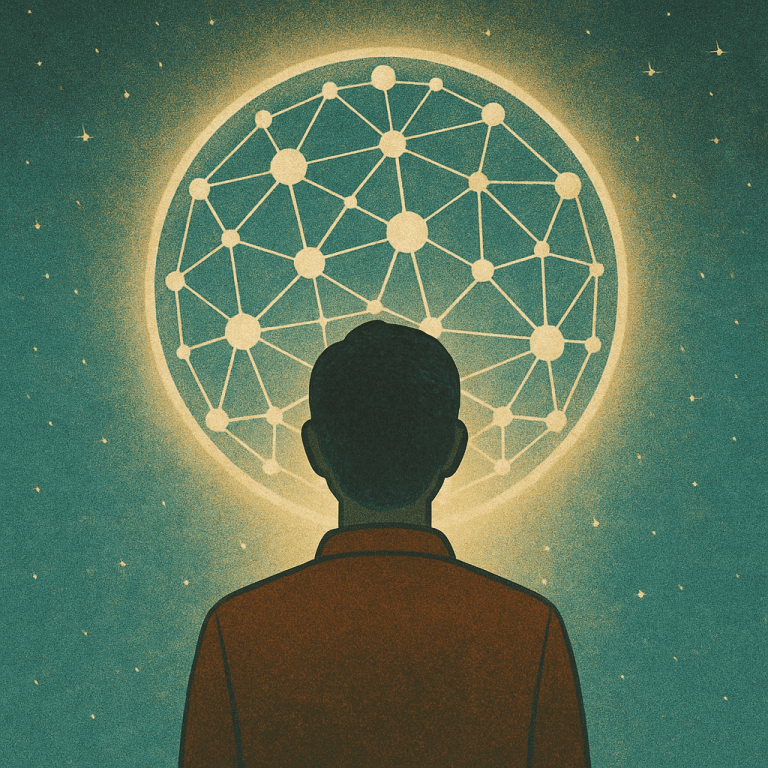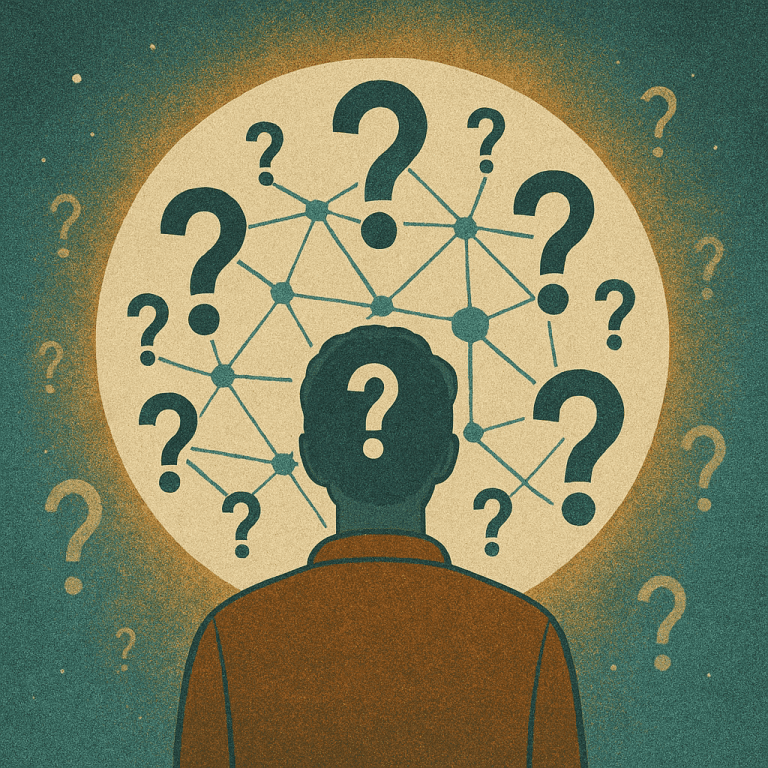How Systems Thinking Emerged Across Time
We often treat “Systems Thinking” as a modern buzzword. But it’s not a new invention — it’s the result of deep inquiry, scientific rigor, and hard-earned insight from thinkers and disciplines that go back nearly a century.
Systems Thinking has roots in wartime strategy rooms, biology labs, philosophical debates, and boardrooms where leaders struggled to make sense of change, complexity, and coordination. Each school of thought added a unique lens, collectively building what we now recognize as the systems thinking field.
Understanding these intellectual roots does more than honor history. It gives you grounding, a richer vocabulary for diagnosis, and helps you choose the most relevant tools and mindsets for your consulting work.
🌐 Cybernetics: Control, Communication, and Feedback
Founders: Norbert Wiener, Ross Ashby, Heinz von Foerster
Era: 1940s–1960s
Core Idea: Systems can regulate themselves through feedback and communication.
Cybernetics emerged during WWII, initially to solve targeting problems for anti-aircraft systems. But it quickly expanded into a field exploring how feedback enables systems — biological, mechanical, and social — to self-regulate.
Key Concepts:
- Feedback loops (balancing and reinforcing)
- Homeostasis (maintaining stability through regulation)
- Observer-participation (2nd-order cybernetics: the observer is part of the system)
Modern Influence:
- Organizational feedback structures
- Foundations of AI and robotics
- Coaching and leadership presence (you influence the system by observing it)
🔍 Consultant’s Insight:
Cybernetics reminds us that effective control isn’t always about force. It’s about shaping the flow of information and feedback. If you want to shift outcomes, start by reworking the feedback loops.
🌿 General Systems Theory (GST): The Universal Language of Systems
Founder: Ludwig von Bertalanffy
Era: 1940s–1970s
Core Idea: All systems — biological, mechanical, social — share universal patterns and structures.
GST invited us to move beyond academic silos and look for the shared principles underlying all systems. It laid the foundation for systems thinking as a holistic, interdisciplinary practice.
Key Concepts:
- Open systems (interacting with the environment)
- Equifinality (multiple paths to the same outcome)
- Interdependence and wholeness (parts make sense only in context of the whole)
Modern Influence:
- Systems modeling and simulation
- Ecosystem thinking in business and tech
- Network science and systems biology
🔍 Consultant’s Insight:
GST encourages you to zoom out. An organization isn’t an isolated machine — it’s an open system embedded in broader social, technological, and environmental contexts. Sustainability starts here.
⚙️ Operations Research (OR): Efficiency in the Face of Complexity
Founders: Patrick Blackett and WWII-era interdisciplinary teams
Era: 1930s–1950s
Core Idea: Use data, logic, and modeling to improve decision-making in complex operations.
OR was born in the heat of war, applying math and systems thinking to logistical and operational challenges. Post-war, it became essential to business and public policy.
Key Concepts:
- Optimization models
- Decision trees and scenario analysis
- Cost-benefit evaluations
Modern Influence:
- Business intelligence and analytics
- Supply chain and logistics optimization
- Systems simulations in strategic planning
🔍 Consultant’s Insight:
OR shows that systems thinking can be rigorously analytical. But also remember: not everything that matters can be measured — and over-optimizing one part can destabilize the whole.
🧠 Organizational Learning: Systems That Think
Key Figures: Peter Senge, Chris Argyris, Donald Schön, Arie de Geus
Era: 1970s–1990s
Core Idea: Organizations must learn and adapt continuously to survive complexity.
This tradition brought systems thinking deep into business. The Fifth Discipline (1990) made it clear: systems thinking is not just academic — it’s essential for adaptive, resilient organizations.
Key Concepts:
- The Learning Organization
- Mental models (assumptions shaping action)
- Shared vision and team learning
- Systems thinking as the “fifth discipline”
Modern Influence:
- Change management and leadership development
- Agile and adaptive organizational cultures
- Psychological safety as a condition for learning
🔍 Consultant’s Insight:
You’re not fixing machines — you’re nurturing living systems. True transformation requires shifting mental models, building learning loops, and cultivating spaces for feedback and trust.
🧭 Why History Matters to Consultants
Knowing where systems thinking comes from helps you:
- Choose the right lens: Use OR for technical modeling, cybernetics for feedback dynamics, GST for holistic framing, or organizational learning for culture change.
- Build credibility: Clients trust insight rooted in intellectual tradition, not just trendy frameworks.
- Find your style: These schools each offer a unique voice — from analytical to humanistic. Knowing them helps you shape your own.
- Avoid blind spots: Systems thinking thrives on cross-pollination — blending logic with intuition, metrics with meaning.
🛠 Mini-Practice: Build Your Systems Thinking Starter Kit
Pick one tradition that resonates with your current challenges. Then choose one of these readings to explore it deeper:
1. Cybernetics
- The Human Use of Human Beings – Norbert Wiener (accessible intro)
- An Introduction to Cybernetics – W. Ross Ashby (technical classic)
2. General Systems Theory
- General System Theory – Ludwig von Bertalanffy (original academic work)
- Thinking in Systems – Donella Meadows (clear, practical, beloved)
3. Operations Research
- Introduction to Operations Research – Hillier & Lieberman (academic but practical)
- OR case studies in logistics, emergency response, or complex scheduling
4. Organizational Learning
- The Fifth Discipline – Peter Senge (essential systems thinking for organizations)
- Overcoming Organizational Defenses – Chris Argyris (on learning and mental models)
🧠 Final Thought
Systems thinking didn’t appear overnight. It was forged in the fires of war, in the complexity of nature, in the ambition of scientists, and in the reflective practice of organizational leaders.
Today, as a consultant navigating uncertainty, you’re not just applying tools — you’re continuing this tradition.
So ask yourself:
Which thread of this story will you follow deeper?
Because the roots of insight aren’t just in books.
They’re in the questions you dare to ask, the models you choose to challenge,
and the patterns you help others finally see.
- The Whisper of the Whole: A Systems Thinking Guide for Consultants
- What is a System, Really?
- The Living Dance of Systems
- Resilience and the Wisdom of Adaptive Systems
- Roots of Insight
- The Systems Thinker’s Compass
- Drawing Complexity
- Peering Below the Surface
- Master Methodologies in Systems Thinking
- Enhancing Familiar Tools with Systems Thinking
- Transforming Business Through Systems Thinking
- Systems Thinking in Public Policy & Governance
- Sustainable Systems
- Systems Thinking for Engineering & Technology
- The Inner System: You
- The Roadblocks
- The Future of Systems Thinking
- Systems Thinking FAQ: Myths, Misunderstandings & Core Insights







